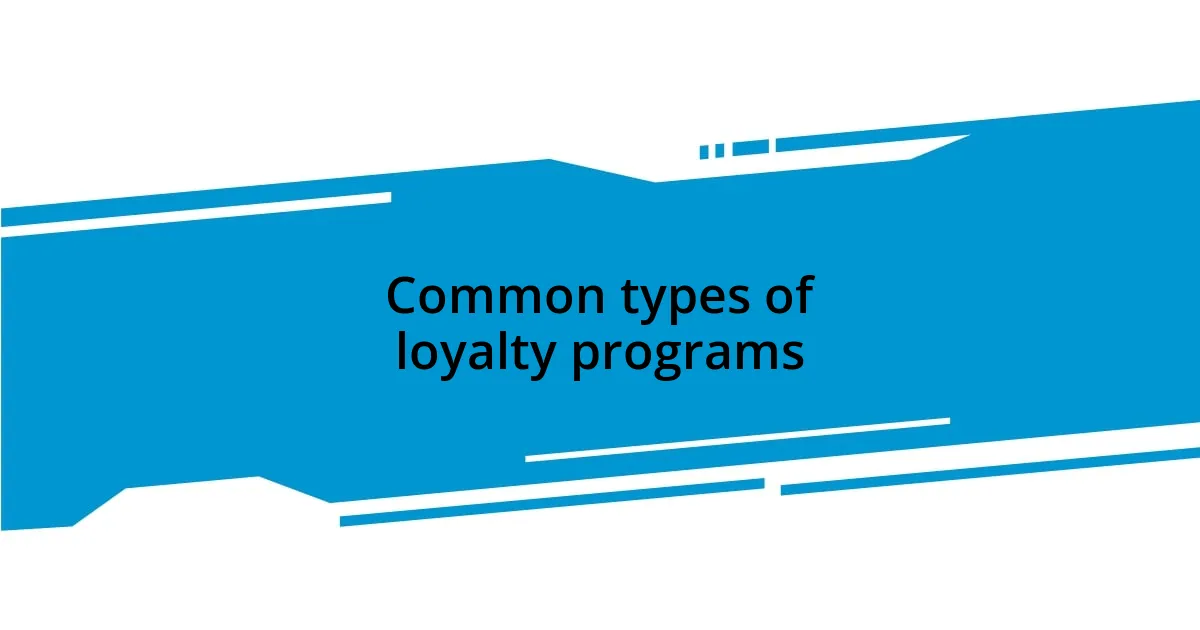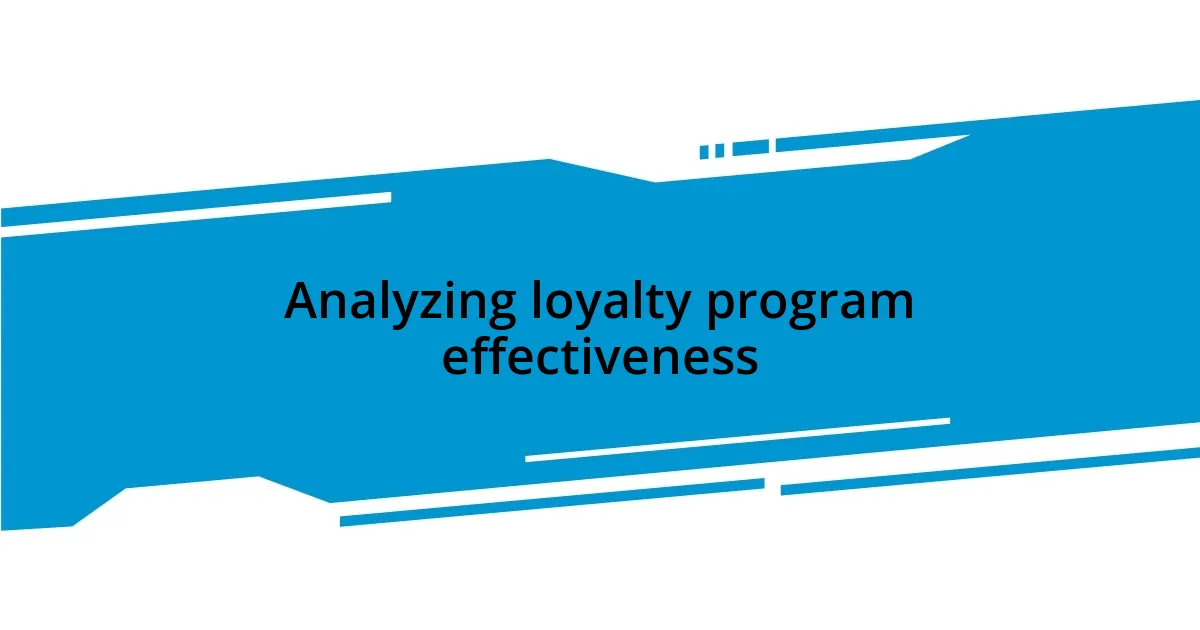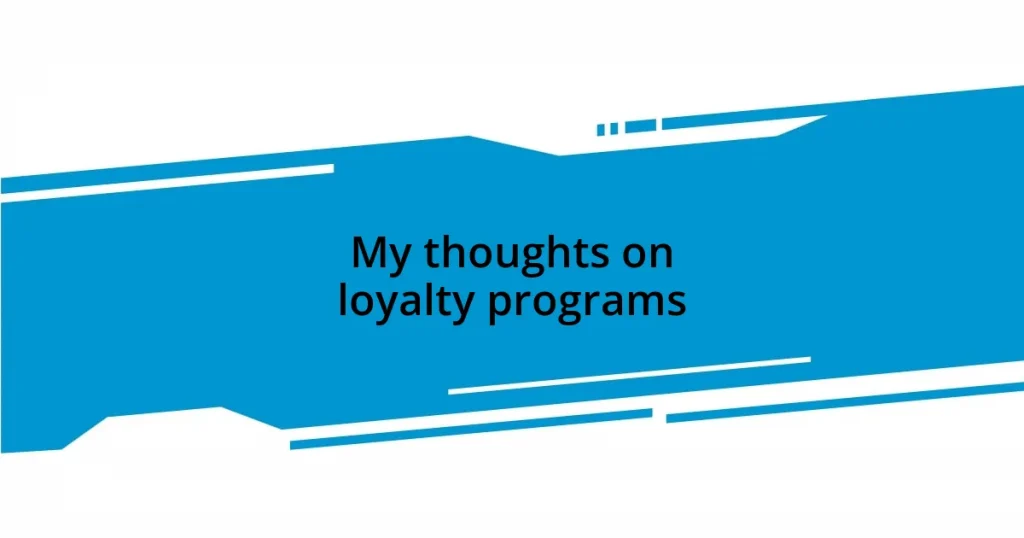Key takeaways:
- Loyalty programs enhance customer satisfaction by fostering emotional connections and offering personalized rewards.
- Common types include points-based, tiered, and subscription-based programs, each appealing to different consumer behaviors.
- Maximizing rewards involves understanding program structures, engaging with brands, and timing purchases around promotions.
- Future trends include technology integration, sustainability-focused initiatives, and experiential rewards that deepen customer relationships.

Understanding loyalty programs
Loyalty programs are essentially reward systems designed to encourage repeat business, often through points or exclusive offers. I remember signing up for a coffee shop’s loyalty card, eagerly collecting stamps with every purchase. It felt gratifying to finally earn that free drink, and it made me wonder: do we seek these rewards for the product itself, or is it something deeper—like the sense of belonging to a community?
These programs thrive on the emotional connection they foster between businesses and customers. When I think about my favorite airline’s loyalty program, it’s not just about the miles I accumulate; it’s the perks that come with them—early boarding, upgrades, and access to lounges. Have you ever noticed how these little privileges can transform an ordinary travel experience into something remarkable?
Another interesting angle is how loyalty programs can sometimes shift our purchasing behavior. I once found myself choosing a specific grocery store just to earn points toward my next shop. While it was a small change, it made me reflect on how these programs subtly influence decisions. Do you think this kind of influence is empowering or limiting?

Benefits of loyalty programs
Loyalty programs offer an array of benefits that enhance both customer satisfaction and business performance. A few months back, I found myself at my favorite local bookstore, and to my surprise, I received a 10% discount on my purchase simply for being a loyalty member. It felt like a little victory, reinforcing my choice to frequent their shop and making that connection more meaningful. This kind of reward not only sweetens the deal but also encourages me to keep coming back.
Here are some of the standout benefits of loyalty programs:
– Exclusive Discounts and Offers: Members often receive special pricing, making products more accessible.
– Personalized Rewards: Brands can tailor rewards based on individual preferences, which adds to the emotional bond.
– Enhanced Customer Experience: Access to VIP services, like priority support or exclusive events, creates a feeling of value and importance.
– Encouraged Customer Engagement: Regular communication and updates keep customers informed, deepening their relationship with the brand.
– Community Building: Loyalty programs often foster a sense of belonging, as customers feel part of a group with shared interests.
I love how these benefits not only reward me for my loyalty but also create a cascade of positive experiences that enrich my interaction with the brand. All these elements combine to make loyalty programs a win-win for consumers and businesses alike.

Common types of loyalty programs
Loyalty programs come in various forms, each designed to appeal to different consumer behaviors. One common type is the points-based program, where customers earn points for every dollar spent, which can be redeemed for future discounts or freebies. I recall joining a popular retail chain’s program; it was thrilling to watch my points accumulate, knowing I was working towards a reward.
Next, we have tiered loyalty programs, where customers climb up levels based on their spending. This structure often leads to a more engaged customer base, as members are incentivized to achieve the next tier for enhanced benefits. I learned this firsthand when I reached “Gold” status at my favorite hotel chain. The perks of my elevated level were palpable—upgrades and complimentary breakfasts truly made my stays feel extra special, almost like being treated as family.
Lastly, subscription-based loyalty programs have emerged, where customers pay a fee for ongoing perks and benefits. Some time ago, I subscribed to a book service that offered monthly deliveries, and I must say, it felt like Christmas every month! This model not only secures my loyalty through upfront commitment but also adds an element of anticipation. Ultimately, various programs cater to diverse preferences, and I often find myself drawn to the ones that align with my buying patterns and emotional experiences.
| Type of Loyalty Program | Description |
|---|---|
| Points-based Program | Earn points for every dollar spent, redeemable for discounts or freebies. |
| Tiered Loyalty Program | Members achieve levels based on spending, unlocking increased benefits. |
| Subscription-based Program | Customers pay a fee for exclusive access to perks and monthly offerings. |

Tips for maximizing loyalty rewards
To truly maximize loyalty rewards, it helps to familiarize yourself with the program’s structure. The more I learned about the specifics of my favorite coffee shop’s loyalty app, the better I got at strategically earning points. Why not experiment with planned purchases? I started buying gift cards during the promotional periods to boost my points quickly. It’s a simple way to gain extra rewards while supporting a business I love.
I’ve also discovered that timing can make a significant difference in reward collection. Last year, during a special holiday promotion, I took advantage of doubled points for every purchase. This little tip has turned my occasional trips into meaningful opportunities to rack up rewards on purchases I’d make anyway. Have you ever considered adjusting your shopping schedule around those promotions? It’s a game changer that often goes unnoticed.
Finally, don’t hesitate to actively engage with the brands. I often find myself reaching out for feedback or sharing my experiences on social media. I remember receiving a surprise bonus for a thoughtful post about a recent purchase. This not only helped me feel appreciated, but it also deepened my connection with the brand. Encouraging interaction is key—after all, businesses love to hear from loyal customers!

Analyzing loyalty program effectiveness
When analyzing the effectiveness of loyalty programs, it’s crucial to look at customer engagement and retention rates. I remember a time when I switched my grocery shopping to a store with a dedicated loyalty program. The instant I signed up, I felt a sense of belonging, which led me to shop there more frequently. This emotional connection often drives customers, causing them to spend more with brands that make them feel valued.
It’s also important to consider how well the program aligns with customer needs. I once joined a program that offered rewards for both in-store and online purchases, catering to my busy lifestyle. The convenience reinforced my loyalty, and I found myself making purchases I might have otherwise avoided. Have you ever felt more inclined to shop simply because a program made it easier for you?
In addition, evaluating the redemption process can shed light on overall program success. I’ve encountered loyalty programs where I had to jump through hoops to redeem points, which quickly dampened my enthusiasm. When I finally found a program with a straightforward, user-friendly redemption system, I felt empowered and appreciated as a customer. So, how easily can your points be turned into rewards? That’s a critical factor in determining a program’s effectiveness.

Potential drawbacks of loyalty programs
It’s easy to get caught up in the excitement of loyalty programs, but I’ve seen some potential drawbacks firsthand. For instance, I once enrolled in a program that seemed fantastic at first. However, I quickly realized that I was spending more money on products I didn’t really need just to earn points. Have you ever felt pressured to buy something just to get a reward? It can be disheartening and frustrating.
Another drawback I’ve experienced is the complexity of certain programs. I remember trying to navigate a loyalty app that was loaded with terms and conditions I didn’t fully understand. I ended up losing track of my points and expiration dates, which left me feeling disappointed. Isn’t it counterintuitive to feel overwhelmed while trying to earn rewards? Simplicity in a program can make a world of difference, but that’s not always the case.
Additionally, loyalty programs can create an illusion of value that might not always be there. I once had a membership that required a significant upfront cost to join, promising exclusive rewards. Yet, after a year of participation, I realized I hadn’t really reaped the benefits I expected. Have you ever felt like you were chasing something that wasn’t worth the effort? It’s essential to evaluate whether the program truly aligns with your spending habits or if it just adds unnecessary pressure.

Future trends in loyalty programs
One future trend I see emerging in loyalty programs is the integration of technology. I recently tried a program that utilized app-based rewards, allowing me to earn points just by scanning my purchase receipts. It felt incredibly seamless! As technology advances, I believe we’ll witness more personalized experiences, driven by artificial intelligence, that tailor offers based on individual spending habits. Isn’t it exciting to think about how brands might know us better than we know ourselves?
Another noteworthy direction is the shift toward sustainability in loyalty programs. I remember when a coffee shop I frequented introduced a rewards system where I could earn points for using my own reusable cup. It made me feel like my little effort contributed to a bigger cause. This kind of initiative resonates deeply with eco-conscious consumers and might just redefine value in loyalty programs. How important is it for you to feel that your spending reflects your values?
Finally, the rise of experiential rewards is something I can personally get behind. Instead of simply accumulating points for discounts, I recently encountered a program that offered exclusive experiences for loyal members, like behind-the-scenes tours and VIP events. That personal touch created lasting memories and a sense of community. Wouldn’t it be nice if brands began prioritizing experiences over transactions, bringing customers together over shared passions?
















